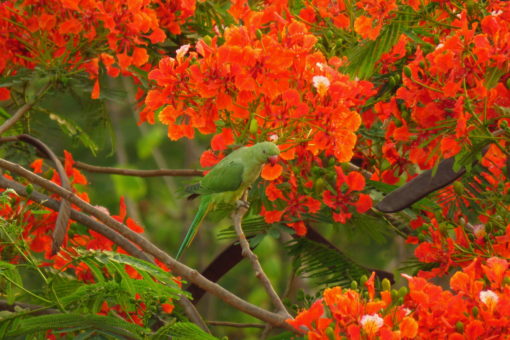Introduction
The Gulmohar plant, renowned for its fiery red blossoms, is a captivating sight in tropical and subtropical regions around the world. Also known as the Flame Tree or Royal Poinciana, this botanical wonder has garnered immense popularity for its stunning aesthetics and cultural significance.
Description of Gulmohar Plant
The Gulmohar, scientifically classified as Delonix regia, belongs to the Fabaceae family. It is a deciduous tree renowned for its broad canopy and flamboyant display of flowers. With its fern-like leaves and vibrant crimson, orange, or yellow blossoms, the Gulmohar stands out in any landscape.
Cultural Significance
Across various cultures, the Gulmohar holds symbolic value. In some traditions, its fiery blooms symbolize passion and vitality, while in others, they represent courage and resilience. Additionally, the tree may hold religious significance in certain contexts, serving as a sacred emblem or featuring in religious ceremonies.
Growing Gulmohar
Gulmohar thrives in warm climates with well-drained soil. It requires full sunlight for optimal growth and flourishes in areas with minimal frost. Propagation can be done through seeds or cuttings, with regular watering and fertilization essential for healthy growth. Pruning helps maintain the tree’s shape and encourages prolific flowering.
Benefits of Gulmohar
Apart from its visual appeal, the Gulmohar offers several benefits. It attracts pollinators like bees and butterflies, contributing to biodiversity. Moreover, its lush foliage provides shade and shelter, creating a conducive environment for other plant species and wildlife. Psychologically, the tree’s vibrant colors can uplift mood and evoke a sense of joy and tranquility.
Drawbacks and Considerations
While Gulmohar is prized for its beauty, it also comes with some considerations. Its vigorous growth and extensive root system may pose challenges in urban settings, leading to potential damage to infrastructure or competition with other plants. Additionally, in some regions, the tree’s invasive nature has raised concerns about displacing native vegetation.
Gulmohar in Landscaping
In landscaping, Gulmohar serves as a focal point, adding drama and elegance to gardens, parks, and avenues. Its striking silhouette and vibrant blooms complement a variety of architectural styles, making it a favored choice among landscape designers. When paired with contrasting foliage or flowering plants, it creates visually stunning compositions.
Medicinal Uses
Traditionally, various parts of the Gulmohar tree have been used in folk medicine for treating ailments like inflammation, skin disorders, and digestive issues. Modern research indicates potential pharmacological properties, with extracts showing antimicrobial, antioxidant, and anti-inflammatory effects. However, caution is advised, as some parts of the tree may be toxic if ingested.
Gulmohar in Literature and Arts
The Gulmohar’s striking beauty has inspired poets, writers, and artists throughout history. References to its vibrant blooms and lush foliage can be found in literature, poetry, and visual arts across cultures. Its symbolism often extends beyond its physical attributes, representing themes of vitality, passion, and renewal.
Conservation Status
Despite its widespread cultivation, the Gulmohar faces threats from habitat loss, urbanization, and deforestation. Conservation efforts are underway to protect native populations and promote sustainable cultivation practices. Reforestation initiatives and community engagement programs aim to safeguard this iconic tree for future generations.
Popular Varieties
Numerous varieties of Gulmohar exist, each with its unique characteristics. While some boast larger flowers or deeper hues, others may exhibit variations in leaf shape or growth habit. Popular cultivars include ‘Flame of the Forest,’ ‘Peacock Flower,’ and ‘African Tulip Tree,’ each adding to the tree’s allure.
Gulmohar in Urban Environments
In urban settings, Gulmohar plays a vital role in green infrastructure, offering shade, mitigating heat island effects, and enhancing aesthetic appeal. However, urbanization poses challenges like soil compaction and pollution, impacting the tree’s health and longevity. Sustainable urban planning and community involvement are essential for preserving Gulmohar in cities.
Mythology and Folklore
In various mythological traditions, the Gulmohar tree holds symbolic significance, representing themes of love, passion, and transformation. Folklore surrounding the tree often narrates tales of bravery, resilience, and the cycle of life. Its presence in myths and legends underscores its enduring cultural relevance.
Gulmohar Festivals
In regions where Gulmohar trees abound, festivals or events celebrating their bloom are common. These festivities often feature cultural performances, art exhibitions, and tree planting drives, fostering community engagement and environmental awareness. Such celebrations highlight the tree’s role as a cultural icon and a source of collective pride.
Conclusion
The Gulmohar plant stands as a testament to nature’s artistry, captivating hearts with its vibrant hues and graceful form. Beyond its ornamental value, it serves as a symbol of vitality, resilience, and cultural heritage. By understanding and appreciating its significance, we can work towards preserving this botanical masterpiece for generations to come.
